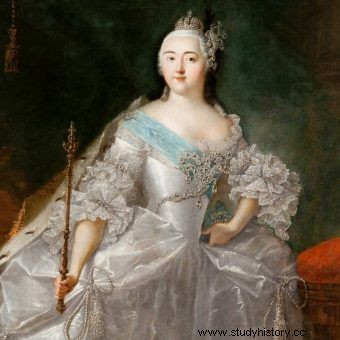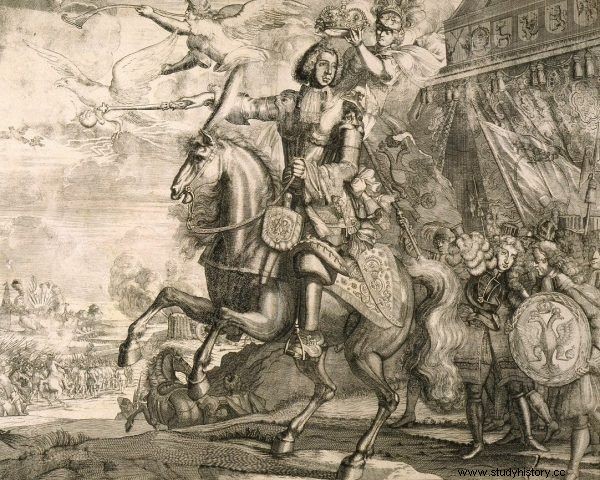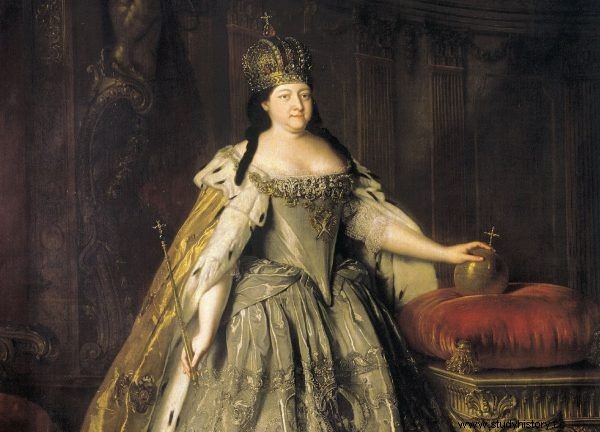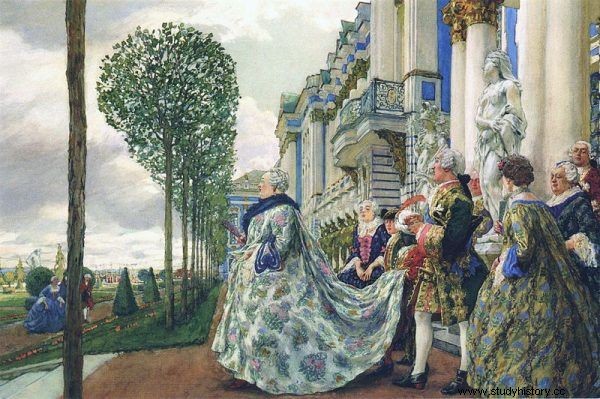Nothing announced that he would make a great career. However, it took Russia's power to new heights and prepared the ground for the partitions of the Polish-Lithuanian Commonwealth. Had it not been for bad luck in love and the decision to bring the future Tsarina Catherine the Great to the country, could the history of Poland have developed differently?
In December 1709, the people of Moscow were getting ready to celebrate. Tsar Peter the Great was approaching the city with his troops, which had defeated the Swedes near Poltava just a few months earlier. For the first time on this scale, the truth that Napoleon and Adolf Hitler will find out about the future was revealed - even the most dangerous army does not guarantee success in the conquest of Russia.

If Elżbieta Romanowa had children of her own, perhaps Catherine II the Great would never have assumed the Russian throne.
The Poltava victory was to turn out to be a turning point in the Great Northern War and, in part, in the geopolitical situation of the whole of Europe. The Swedes were never so strong again, and Charles XII lost his reputation as undefeated. On the other hand, Russia took the first step towards imperial power , the victim of which was soon to fall to the Polish-Lithuanian Commonwealth.
Name after the tsarist mare
The celebration, however, had to be postponed, because a message reached Piotr from the settlement near Moscow, Kolomienskoye, where the daughter of a Baltic peasant was giving birth to a second child. However, this was not an ordinary peasant girl, but the tsarist lover, the future Empress Catherine I. Upon hearing of the birth, Peter ordered the celebrations to be postponed and went to welcome his next daughter to the world.
The girl was called Elizabeth, a name never seen before among the Romanovs. There are many attempts to explain this decision, but the most colorful (and at the same time quite probable) theory is that the tsar has a special fondness for the diminutive Lizett. Such was the name of, among others ... his beloved mare, on which he won the Poltava victory , tsarist dog and one of the first ships built in Russia designed by Peter.

According to one of the theories, Elżbieta was named after ... the favorite mare of Piotr the Great.
Whether the future ruler of Russia was named after a horse is hard to say. And - at least initially - no one thought about it in particular. Although Peter never denied his offspring, under the law, Elizabeth and her sister Anna (the only one of at least eight siblings who survived the infancy) were bastards. They became his official daughters only after their marriage in 1711. Until then, Catherine was merely a tsarist lover of peasant origin.
However, legalizing the relationship changed everything. The family moved to the salons of St. Petersburg, which from 1712 became the official capital of the empire. The young tsarevna received a real courtly upbringing with the inherent learning of languages. She was said to be fluent in French as early as in her teenage years , which won the sympathy of the Parisian envoys who reported to the country about its beauty and wisdom. The feelings were mutual, because Elizabeth remained a great francophile throughout her life.
Unrealized plans, disappointed hopes
The interests of the girl harmonized with the decisions of her father, who made efforts to make Elizabeth the future empress of France. The message sent was taken as customary, but the Bourbons replied politely but firmly - not for the Romanovs the Versailles chambers, they must be satisfied with their St. Petersburg copies . Louis XV finally chose another Slav - the daughter of the Polish king, Maria Leszczyńska.
Another contender for Elizabeth's hand was the twenty-year-old prince of Lubeck, Karl August von Schleswig-Holstein-Gottorf. This time the messengers with the portrait of the Russian candidate were successful and, encouraged, the prince went to St. Petersburg to meet the chosen one and plan the ceremony.
The choice seemed perfect. Karla's cousin had already married Peter's older daughter, Anna, and in addition - although Lübeck was no match for Paris - the young prince had a good chance of taking the throne of Sweden. Unfortunately, this time Elizabeth was not lucky . The fiancé was so passionate about marriage that in the heat of preparations he died without waiting for the wedding.
Meanwhile, with age, Peter the Great began to suffer more and more from the main problem of all monarchies - the lack of a male heir (his firstborn, Alexius, died seven years before him, and the rest of his sons did not reach adulthood). Immediately after his death in 1725, Catherine I assumed power, but biology was inexorable and she too had to start thinking about a successor as soon as possible. Ultimately, the plan in the will assumed that Peter II, son of Alexios, would sit first. Next in line was the older Anna, followed by Elizabeth.
Peter II did not enjoy power; at the age of only 15 he died childless of smallpox. The throne should therefore fall to Anna, but Anna had been dead for two years. In accordance with Catherine's will, Elizabeth was to be crowned in such a situation, which, however, was not to the taste of the aristocracy.
The election was strongly opposed by the deserving family of Dolgorukis. This family originated from the founder of Moscow, Jerzy Dolgoruky, a descendant of Vladimir the Great himself, the baptist of Rus. They counted on the strengthening of the oligarchy in Russia and the enactment of laws that would restrict the tsar's powers. They managed to bring the throne to Anna Ivanovna, Elizabeth's cousin and daughter of Peter the Great's older brother, and when she died in 1740, she was replaced by the underage Ivan VI (the actual regent was ruled by his mother - Anna Leopoldovna) .

Instead of Elizabeth, her cousin, Anna Ivanovna (pictured), sat on the throne.
Biggest dream? Follow in your father's footsteps
Meanwhile, Elizabeth withdrew into the shadows and returned to her beloved Moscow, where she led a quiet life. This is how she describes her attitude to the old capital in her new book, Niepokorne. Strong women of the Romanov Empire ”Andrzej Andrusiewicz:
From childhood, she was associated with Moscow and the villages of Prieobrażenskoye and Izmailovo. When her father moved the capital to St.Petersburg, she went there reluctantly. Her love for Moscow, symbolizing the old Ruthenia, remained with her for the rest of her life. She often returned there and spent long hours in the local churches, kept fasting, and systematically visited the Troitskaya Lavra. She appreciated the Moscow tradition and Old Russian simplicity.
The peace of the villages near Moscow, however, could not give her what St. Petersburg palaces do - power. Additionally, encouraged by part of the aristocracy, she decided to lead the conspiracy, which in 1741 gave her the coveted crown. At the head of the three-hundred-person guard, she entered the winter palace, which was still wooden at the time, without any major problems, and then told the regent to get out with her son as soon as possible, because from today she, Elizabeth, takes over the rule.
The change was welcomed, the aristocracy had already been disappointed in Anna Ivanovna. Contrary to predictions, her rule was not at all in line with the interests of the oligarchy. In addition, the main role in the state was played by the favorite and advisor of the ruler Ernest Biron - the gray eminence of the tsarist court . After the takeover of the crown by Ivan VI, it was not better. Elizabeth - with the support of her subjects - finally achieved her goal and was able to pursue a policy of strengthening Russia, continuing her father's work.
She ruled for two decades, winning especially the commoners of the empire. During this time, she laid the foundations for the Russian enlightenment, which flourished for good under her successor. The first Russian university was established in Moscow at that time. Meanwhile, in St. Petersburg, the so-called Elizabethan Baroque style developed, including the new Winter Palace, Tsarskoye Selo and the suburban Peterhoff residence.

Elizabeth quickly found herself in the courtly reality. In the picture - during a visit to Tsarskoye Selo.
Elizabeth quickly found herself in the new reality. The masquerade balls she organized, during which men donned ball gowns and ladies - uniforms, have gone down in history . According to one version, she was encouraged to do so by a French diplomat and spy Charles d'Eon, famous for impersonating a woman. The basic mission of the French, however, was to encourage Elizabeth to become involved in the Seven Years' War that was currently underway.
As it turned out, Elizabeth was no less lucky in this matter than her father. The Russian army quickly tilted the scales of victory to their side, occupying the Prussian territories from Konigsberg to Berlin. The days of Frederick II seemed to be over when, with the help of the unexpected future of Elizabeth's death and the political moves of her successor.
Who was really pulling the strings?
In her case, too, the question of the succession to the throne was not straightforward. Elżbieta, however, decided to settle it on her own, and the consequences of her decision were soon to change the map of Europe. Who knows, maybe if the ambitious tsarina had more luck in love, the fate of not only Russia, but also the fate of the Republic of Poland would have happened otherwise ?
After her youthful failures, Elizabeth remained unmarried forever. To this day, rumors circulate about her secret wedding with the favorite Alexei Razumowski, a Ukrainian Cossack endowed with a beautiful voice. However, the rumors were never confirmed, because Razumowski was supposed to destroy all evidence after Elizabeth's death. However, it was supposed to be a morganatic marriage, so it would not influence the choice of an heir.
Taught by experience, Elżbieta decided to choose a successor during her lifetime. As he describes in the book “Niepokorne. Strong women of the Romanov Empire ”Andrusiewicz:
Elizabeth appointed the thirteen-year-old Charles heir to the throne and proclaimed the grand prince with the title of His Imperial Highness. Under the influence of her insistence, Karol converted from Protestantism to Orthodoxy and took the name of Piotr in memory of his great grandfather, and in honor of his father his shed name Fiodorowicz (from the name of Frederick).
A descendant of two dynasties was to sit on the throne:the Romanovs (by his mother and grandfather) and the Holstein-Gottorp (by his father). Elizabeth ended the family game over the tsarist crown as she wanted, preventing bloody events from happening in the future.
The choice of a successor, however, was only half the success, it still had to be sewn together. The new chosen one of the future tsar was Sophia Augusta, who went down in history as Catherine II the Great. As befits a typical marriage of convenience, it was not a kopeck of love. Worse, the young couple was so mismatched that they just didn't like each other. Andrusiewicz notes that it was Elżbieta's failure. For her, however, the most important thing was to secure the throne by the offspring of Catherine and Piotr. In 1754, Katarzyna fulfilled her task and gave birth to a son, later Emperor Paweł I Piotrowicz.
The strife grew stronger after Elizabeth's death, when Peter III Fyodorovich finally sat on the imperial throne. The ruler first ordered the retreat of the Russian troops, which were defeating the Prussian army during the reign of Elizabeth. The "miracle of the Brandenburg house", as this sudden shift in politics was used to describe, probably resulted from the personal sympathies of Piotr, who himself came from Prussia and never had a special affection for Russia and even spoke Russian not very well.
His opposite was Catherine, who, thanks to her demonstrative love for a new country, religion and culture, quickly won over both the elite and the common people. As a result, Piotr was not allowed to rule for even six months. In July 1762 there was a palace coup, as a result of which Catherine expelled her spouse. Ten years later, as an independent ruler, she partitioned Poland for the first time. It was the beginning of the end for Poland. However, if not for Elizabeth, who brought Katarzyna to Russia, this story might not have happened at all ...
